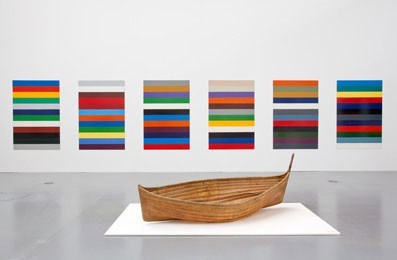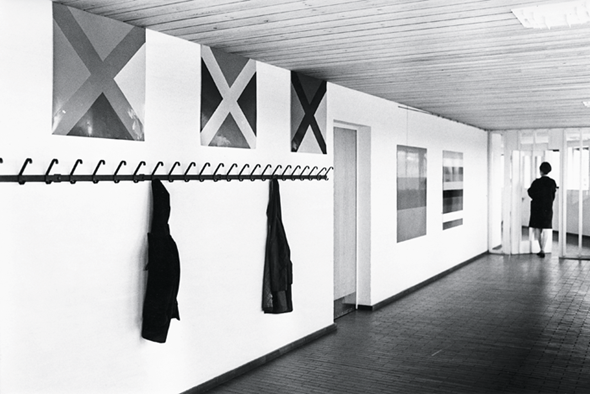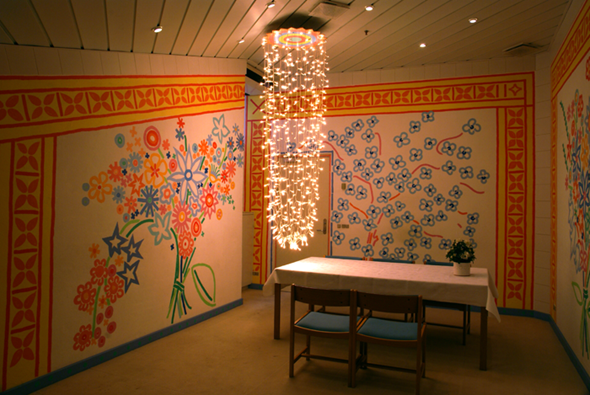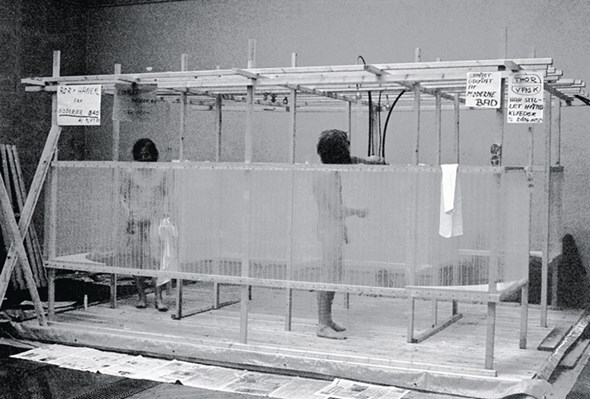
Social Colours, Taking a Relational Shower
I.
What do such different artists as Monica Bonvicini and Rosemarie Trockel, Pae White and Cosima von Bonin, Gerwald Rockenschaub and Rirkrit Tiravanija, Olaf Nicolai and Jorge Pardo all have in common? Their artistic work is based more or less directly on that of Poul Gernes. Until recently this Danish artist was well known among fellow artists but less so in the general public. It was the Cologne-based artist Cosima von Bonin who brought Gernes into the general discourse about aesthetic matters when she integrated some of his works into her show at the Kunstverein Hamburg, Bruder Poul sticht in See [Brother Poul sets sail] (2001), originally conceived as a solo exhibition. There she showed a white sail boat, made inspired by the tradition of Gernes, and in addition she also exhibited all the Dane’s still existent Target Paintings, which Bonin had copied as tapestries. A few years later it was also Bonin who initiated the inclusion of works by Gernes in 2007 at the documenta 12 in Kassel.
II.
This is another way to approach an artistic oeuvre: you enter the name »Poul Gernes« in an Internet search engine under »search pictures« and then wait to see what comes up on screen. The subject of this search would doubtless have appreciated this procedure, since it has both a collective and an anonymous character. These things, collective action and anonymity, are central elements in Gernes’ aesthetics.
So back to the Internet, which promises us as many as »12,700 results«. On the first coloured page we see not only a photographic portrait of the artist, born in 1925 and deceased in 1996, with a flowing beard, but also important groups of works by Gernes in installation views and as separate works. The series begins with two black-and-white photos: a human backside sitting on a glass plate has been photographed from below; it is Gernes’s own, although that is not made clear in the work. On the contrary: in 1969 he used this part of the body to comment with Post-Dadaist satire on the middle-class struggle for individuality, and so he not only photographed his still anonymous backside naked but also presented a plaster cast of it as a sculpture in 1967. Incidentally, as early as 1960 he ennobled a toilet lid with red-and-white stripes and a black flushing button.
The already mentioned Target Paintings occur three times on the Internet page. At the beginning of the 60s, Gernes started to paint a series using this motif, located at the interface between representation and abstraction and also on the boundary between free art and applied design. Concurrent with American artists, he used glossy industrial paint. Radiant beauty and quick understanding, collective picture production and the lapidary appeal to target orientation intersect in these variant-rich compositions, where monochromatic rings of colour range around the central point of focus. As we go on searching for images we find even more abstract compositions: pictures with lines, stripes and points. They are also painted in series; one searches for auratic individual pictures in vain. In the mix we suddenly see paintings and posters with floral and ornamental patterns. Even here it is obvious: Gernes consistently avoided a style that would be characteristic of him, preferring a corporate design that does not deliberately exclude any feasible language of pictures and forms.
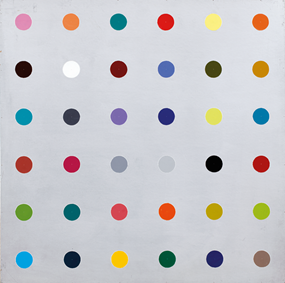
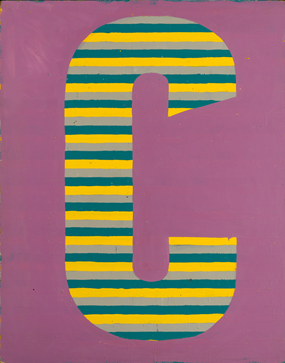
And yet one picture seems to stick out in this Internet search: a photo of a lamp. This object of utility is also one of the works of this artist, who, since the 50s, increasingly turned to furniture design, designing chairs, tables and lamps. In the tradition of the Bauhaus, his artistic strategies, like his abstract lines, naturally flowed over into his products, attempting to bring art and everyday life closer together. For this very reason, from the end of the 60s on Gernes began as an artistic service provider, with the visual design of a town hall, a hospital, a cinema and a bakery. That these interior and exterior design elements, which vary the form language of his abstract and floral pictures, can also be seen as decoration did not trouble him in the least. Rather, in 1981 Gernes asserted: »For some years now I have required of my art that it should give pleasure to my fellow beings and not become an aesthetic ego trip«.
Two work groups by the artist, however, cannot be found on this Internet page: Poul Gernes’s poetic boat constructions and his films.
III.
In 1943 the SS brutally repressed the uprising in the Warsaw ghetto, but in the Second World War the Allies ultimately obtained the upper hand after defeating the Germans at Stalingrad, Lebanon attained independence, Bertolt Brecht’s The Good Person of Sezuan had its premiere, Mick Jagger and Blinky Palermo saw the light of day. And Poul Gernes painted – a good fifteen years before the birth of Pop Art and more than 20 years before the appearance of Roland Barthes’ essay »The Death of the Author« – his groundbreaking picture Untitled, where the text »Good Year Shanghai« can be seen. The three words are written in capital letters in ink on white paper, by hand but repudiating any distinctive handwriting, for Gernes painstakingly follows the given layout. And yet the picture in the field of tension between faithfully delineated imitation and sensitive transformation develops as an artefact of a beauty both delicate and minimalistic. In this way, this ingenious painting is an early signal of what is to come later in the artist’s mature work.
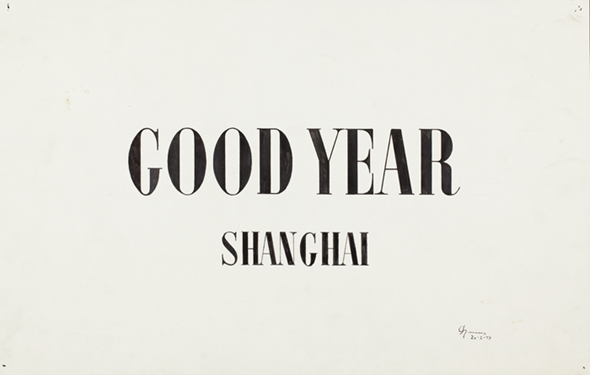
IV.
The avoidance of autonomous authorship, and this is what matters, does not serve any artistic end in itself but emphasises the possibility for a person to act as a social being, a communal subject that can be embedded in collective structures, just such a collective structure was initiated by Gernes when he founded, together with the art historian Troels Andersen in Copenhagen, the Experimenting Art School, the Eks-skolen. This school was planned as a counter-model to the historically saturated Art Academy, emphasising not only an experimental, inter-media approach to art, an experiment in the fields of happening and performance, collage and film but also and above all a non-hierarchical cooperation of students and non-students. The second group included »teachers« like Per Kirkeby, John Davidsen and Peter Louis-Jensen. Exhibitions were organised jointly, such as the Happening-Festival in October 1966, to which even Joseph Beuys made a contribution. Artistic work was also carried out jointly and repeatedly, with the individual authorship often unnamed. In this way the collective at the Eks-skolen pursued its emancipatory and political qualities consistently up to its dissolution at the beginning of the 70s. At this time, Gernes lived with his wife and two children in a leftwing commune, jobbing as a »social worker« and renovating public buildings with drug addicts.
V.
Among the high points of Gernes’ collective and interactive or, if one will, relational art, are doubtless two ideas, of which regrettably only one was ultimately realised: the conversion of an exhibition space into a public shower and a presentation and working area for corporations and businesses. The first was realised in 1969 at the Festival 200 in the Copenhagen art gallery of Charlottenborg: the installation Big Collective Shower offered visitors of both genders the opportunity to take a shower together in the exhibition – »relational aesthetics«, as it was called by Nicolas Bourriaud in the 90s, found its early expression here. A few months later, in 1970, Poul Gernes planned to invite a range of firms to present stands as part of the Tabernakel exhibition in the Danish Louisiana Museum of Modern Art. The intention of the section Citroën in Louisiana, for example, was for the French car manufacturer to present its models on low pedestals in the museum park, and, in addition, an advertising campaign for the exhibition should have been created. An operational bowling alley, automatic dispensers with free ice cream, a working night school and the operation of a boatyard were also planned. Unfortunately, the artist was not able to persuade the curators of the museum of the importance of his groundbreaking ideas. No doubt Rirkrit Tiravanija, at that time nine years old, would have felt totally at home in this both complex and lifelike situation, which reminds one not only structurally of Tiravanija’s later exhibition Social Capital, in Zurich’s migros museum in 1998, where he reproduced a supermarket in the exhibition hall.
Translated by Nelson Wattie
RAIMAR STANGE is a critic and curator. He lives in Berlin.
POUL GERNES, born in 1925 in Copenhagen. Died in 1996 in Sweden. Recent exhibitions include Poul Gernes, Deichtorhallen Hamburg/Malmö Konsthall/Lunds Konsthall (solo) (2010/2011); Poul’s Circle Performance, Galerie Sabine Knust, Munich; Bilder über Bilder, MUMOK, Vienna (2010); Galleri Bo Bjerggaard (curated by Per Kirkeby), Copenhagen (2009); Painting Now and Forever, Greene Naftali Gallery, Matthew Marks, New York (2008); documenta 12, Kassel; Fish and Ships, Kunsthaus Hamburg; Behind, Galerie Ben Kaufmann, Berlin (solo) (2007).
Represented by GALERIE BEN KAUFMANN, Berlin; GALLERI BO BJERGGAARD, Copenhagen
